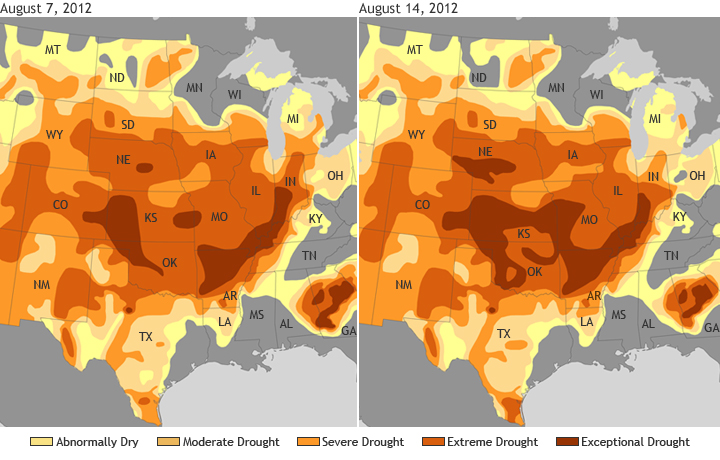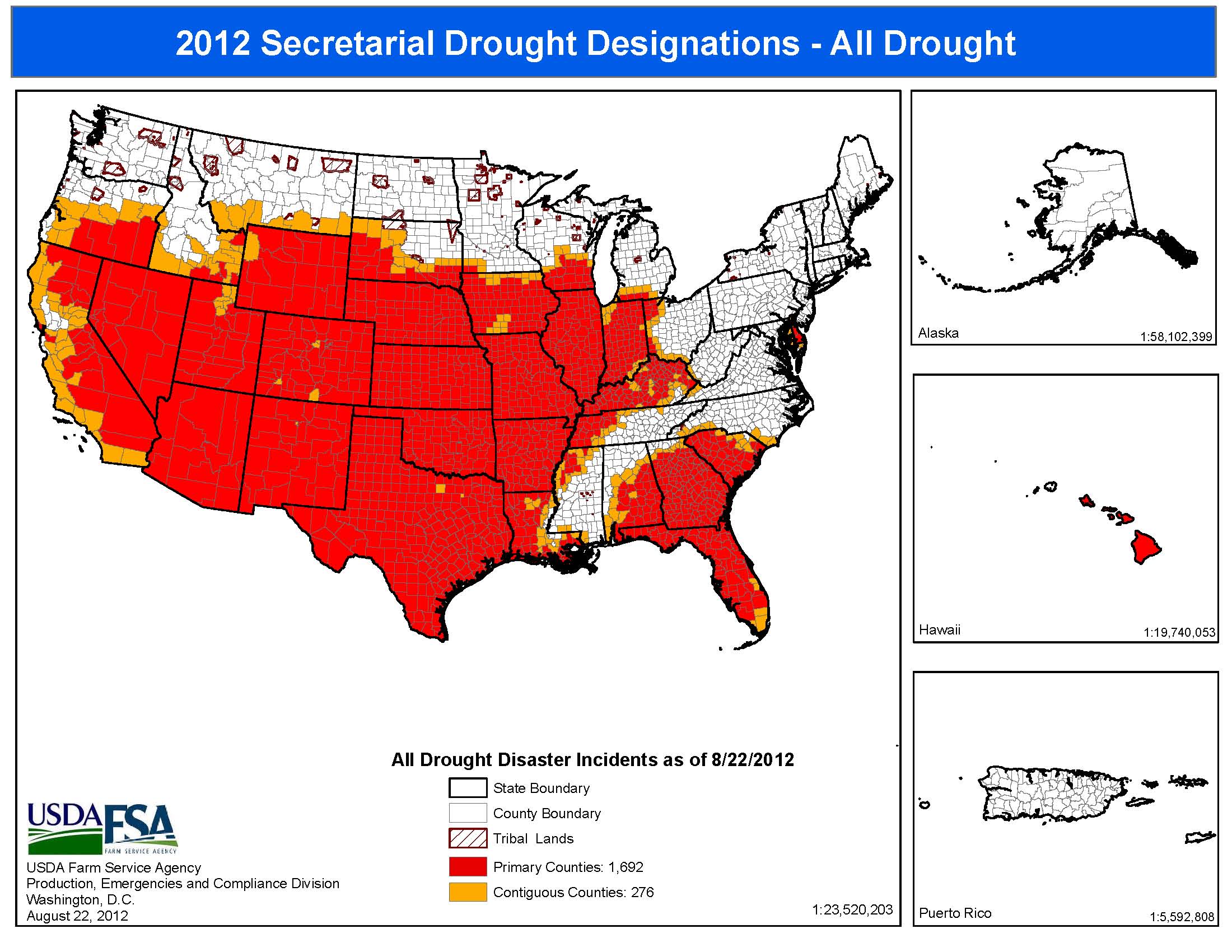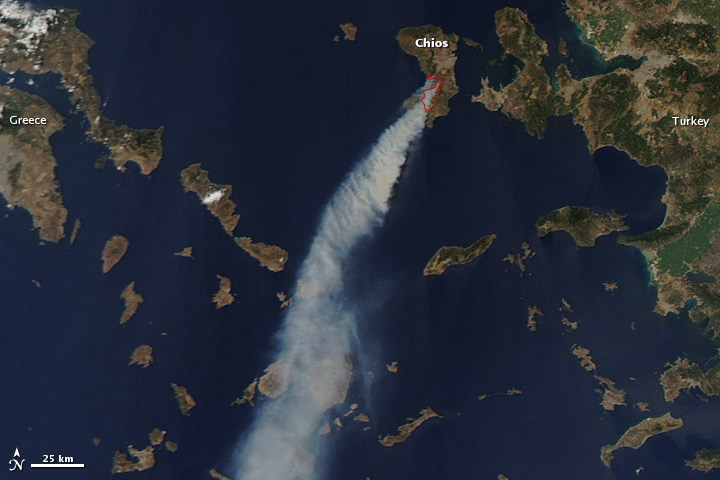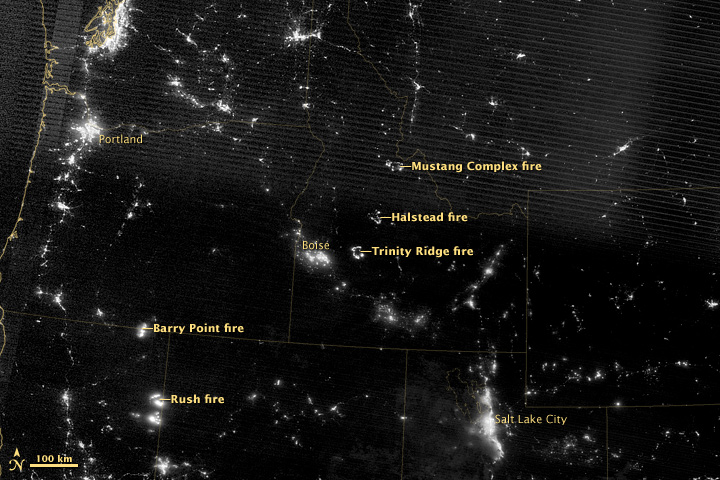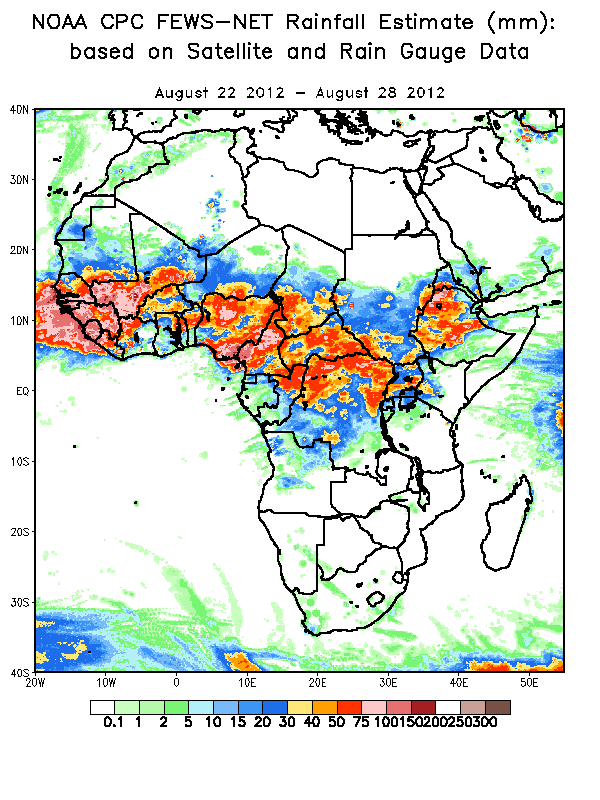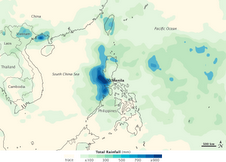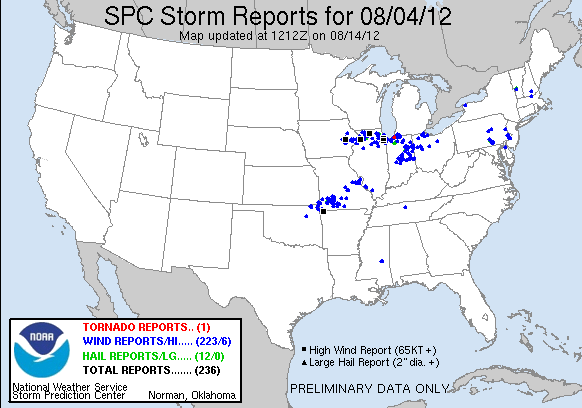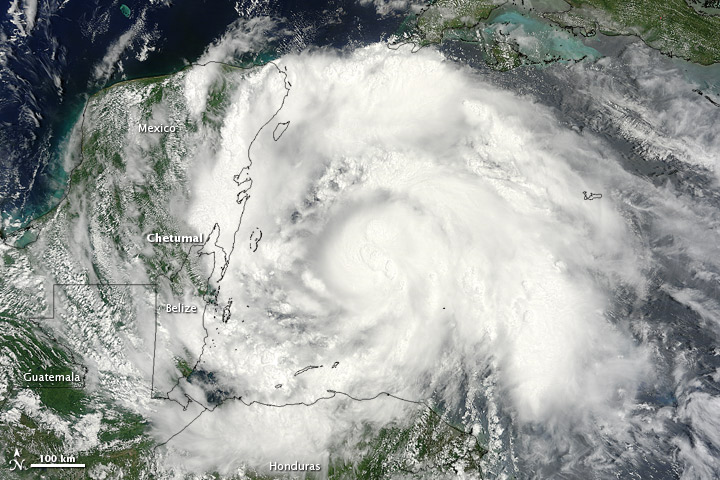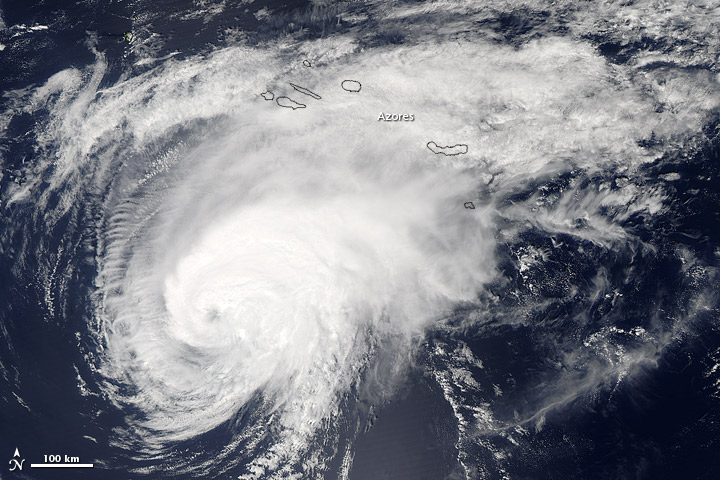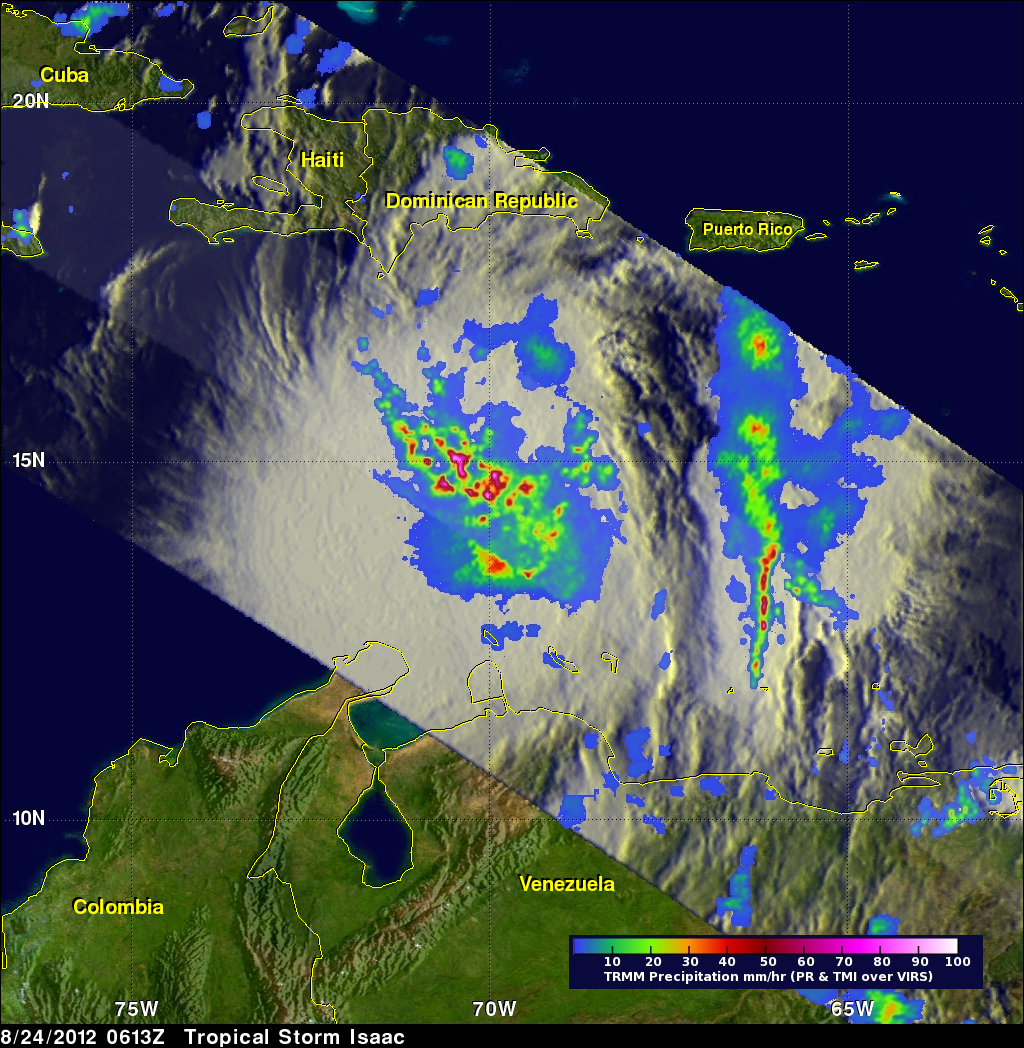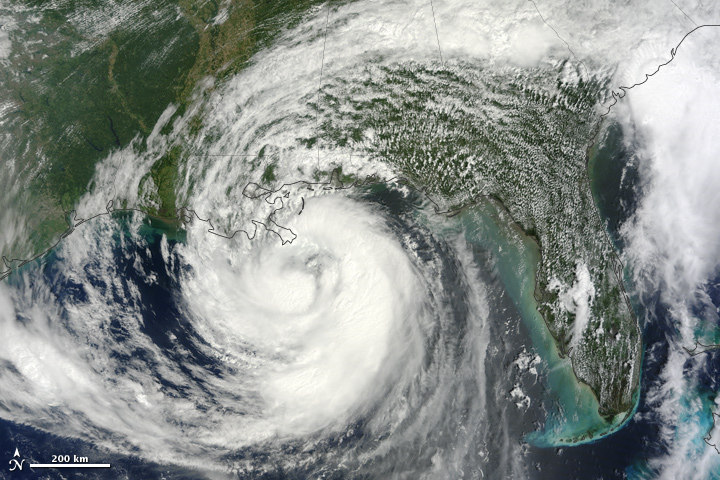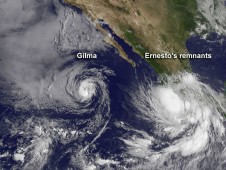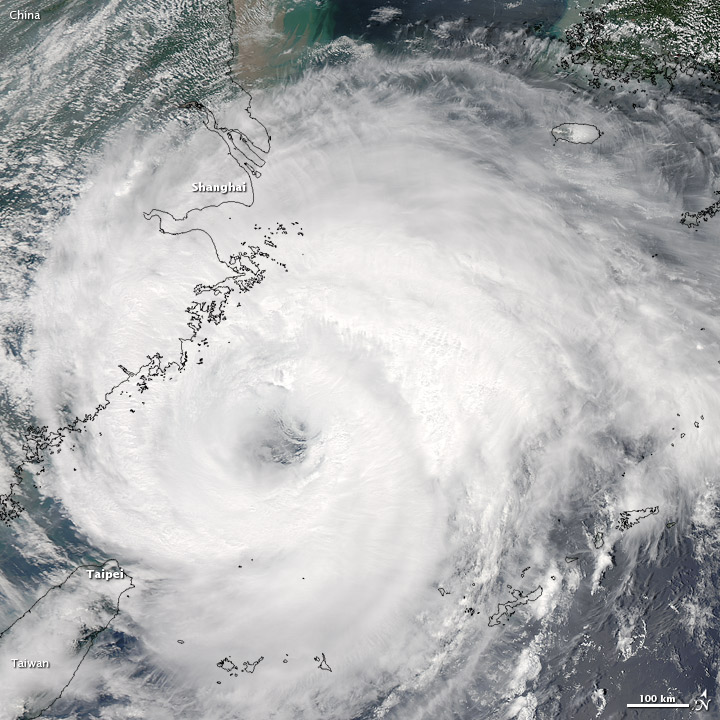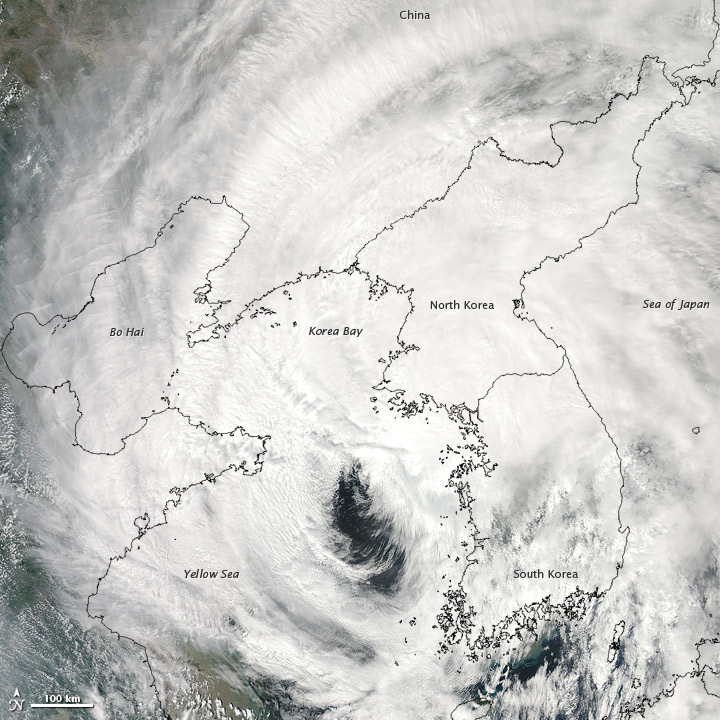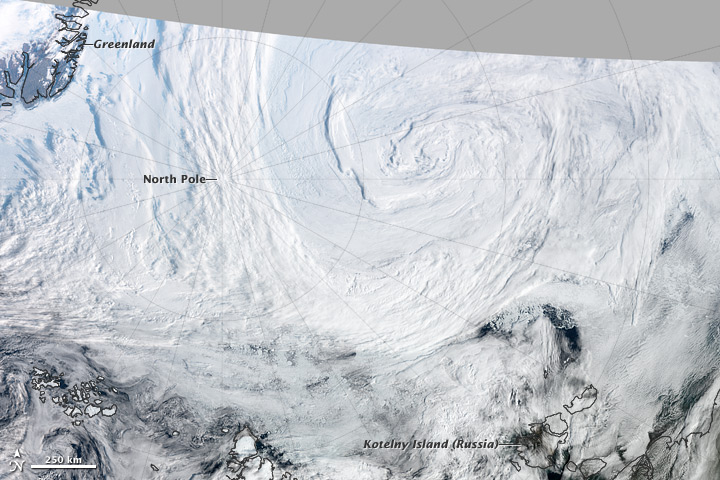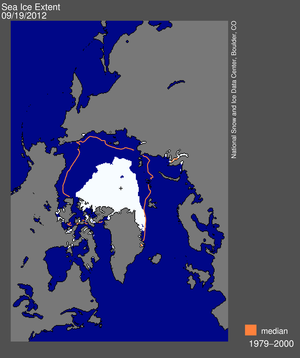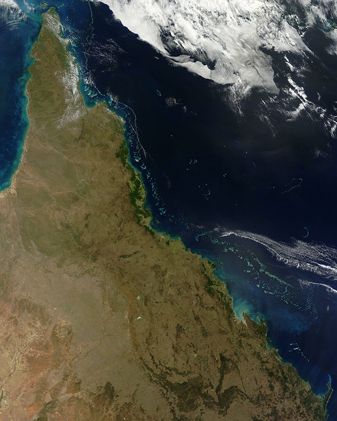Updated 21 Sep 2012

World Meteorological Organization (WMO) leaders expressed concerns regarding global drought while advocating for national drought-management policies on August 21st in Geneva, Switzerland. Citing the impacts to food, water, health, and energy sectors, a summit to address water consumption and conservation issues will be convened in early 2013.
Prolonged drought effects were evidenced around the Northern Hemisphere during August. In the Sahel region of western Africa, the lack of rains resulted in extremely dry pasture lands and poor harvests, and served as a factor in worsening the hunger crisis within those countries. Humanitarian relief efforts were deployed to address famine and poor living conditions for an estimated 10 million people being affected, according to media reports. Likewise, similar water deficits, preceded by three successive seasons of drought across the Horn of Africa, adversely impacted several million people and contributed to the recent exodus of Somali residents where nearly 11,000 people have left the country since April 2012 to take up refuge in bordering countries. In Kenya, the Russian Federation donated wheat flour valued at $2 million U.S. dollars to aid nearly 3 million drought-affected poor residents and refugees.
In the contiguous U.S., drought persisted and engulfed more than half the country. Dry conditions affected an estimated 164 million U.S. residents. As of the latter part of August, 1,692 of the nation's 3,143 counties were deemed as natural disaster areas due to drought. Cited by the U.S. Department of Agriculture (USDA) as the most severe and extensive drought in at least 25 years, the drought adversely impacted 65 percent of the U.S. cattle production and about 75 percent of corn and soybean production. As a relief measure for the American livestock producers, the USDA announced plans in August to purchase up to $170 million U.S. dollars of pork, lamb, chicken, and catfish for federal food nutrition assistance programs.
Within the state of Hawaii, extreme drought forced reduction of the islands' cattle herds by about one-third due to lack of grass, according to media reports. At the Nature Conservancy's Niobrara Valley Preserve in northern Nebraska, drought and wildfires severely damaged its two pasture areas. Fire damaged about 11,000 acres, notably to those rangelands most accessible for public viewing of Great Plains bison. The lack of sufficient grazing area for the herds hastened the sale of more than 100 bison.
The August rains in Canada's Ontario province did not ameliorate the region's drought. According to media reports, Ottawa Valley farmers considered importing citrus pulp from Florida as a replacement feed for livestock, as the Canadian corn crops were severely damaged and hay prices have sharply risen during the drought. Fruit crops such as apples, which produced only one-fourth of the typical harvest, and next year's strawberries were in jeopardy.
Wildfires scorched regions around the Mediterranean Sea and southeastern Europe. According to media reports, 30 wildfires blazed across southern Italy and close to 900 people were evacuated near Sicily's Zingaro National Park, a reserve of 4,000 acres. A forestry worker died while battling the flames. Much of Italy has experienced drought for several months. Nearly 600 wildfires charred parts of Greece, forcing evacuations while injuring two persons and destroying over 3,000 acres near Megalopoli while a major blaze on Chios destroyed at least 37,000 acres and rendered severe losses of the world's only mastic groves. The mastic gum industry yields an estimated annual revenue of $3.75 million U.S. dollars in Greece. In southern Bulgaria, multiple wildfires raged—one fire near Krumovgrad forced evacuations of residents and another fire near Belitsa destroyed about 988 acres—while close to 300 brush fires burned across the country. Thunderstorms brought relief to Bulgarian firefighting efforts by mid-month.
According to media reports, a brushfire on August 27th in Queensland, Australia, caused a power loss to 450 customers when two utility poles were burned near Cloncurry. The wildfire, which scorched over 18,500 acres, caused a brief stretch of highway to be closed and forced a temporary evacuations of two homes as well as 20 persons from a local hospital. A New South Wales fire initially intended as a prescribed burn within the Bowen Mountain National Park was spread by strong winds on August 30th. The 7,400-acre blaze encroached to within about 2 km (one mile) of a residential area.
Wildfires burned fiercely in the northwestern U.S. during August. In the state of Washington, the massive Taylor Bridge Fire destroyed more than 60 homes, scorched 28,000 acres, and forced evacuation of over 400 homes, according to media reports. In Idaho, the death of a firefighter occurred from being struck by a falling tree during efforts to battle the Steep Corner blaze. Please see NOAA's Wildfires page for additional information.

Intense high pressure systems tracking across northern Africa into the Mediterranean countries prolonged the heatwave for Central Europe in August. During the first week of the month, over 180 people in Romania received medical treatment for heatstroke while Serbia experienced temperatures soaring up to 46.0°C (114.8°F). On August 7th the daily maximum temperatures reached 37.0°C (98.6°F) in Rome and 44.0°C (111.2°F) in Agrigento, Sicily, according to media reports. At mid-month, heat advisories were issued for six provinces across south-central France as temperatures hit the triple digits while wildfires erupted in the country's southwestern region. For parts of France and Germany (also hitting triple digits), such extreme heat had not occurred since the 1920s. In Italy, to help relieve dehydration and potential heatstroke, the animals at the Rome Bio-Park were treated to iced foods in August. Giant ice cubes containing raw meat were provided to the tigers, lions, and leopards. Primates received bamboo canes filled with frozen yogurt and watermelon. In late August, the Balkans continued to swelter and temperatures topped 41°C (106°F) on August 26th at Loznica, Serbia.
Australia's extreme temperatures were themselves an extreme, as the nation experienced net warmth during August. While maximum temperatures stayed above-average for the month (6th warmest August), the minimum temperatures dipped (14th coolest August), based upon Australian records since 1950. Consequently, the country's diurnal temperature range anomaly of 2.32°C (4.18°F) constituted the highest on record for an August month. Western Australia recorded its second-warmest August since 1950, with the two regions of Pilbara and Kimberly having their record-high August maximum temperatures. A cold front passage dropped nighttime temperatures to below freezing in the Blue Mountains west of Sydney on August 9th as light snow fell, according to media reports. Tragically, at least four deaths resulted from multiple house fires coincident with the mid-month cold snap in New South Wales. Authorities suspected unattended heating applicances as being a likely cause of the fires.

During August, several parts of the world dealt with severe damages and death rendered by monsoonal rains and flooding. Nations in Africa and southern Asia were notably impacted.
Above-average rainfall across east-central Africa during the first week of the month produced localized flooding causing displacement of at least 15,000 people throughout Sudan. According to media reports, 32 deaths from floods in Sudan have occurred since mid-June. To the west, torrential rains destroyed homes, displaced several hundred people, and flooded farmlands in Nigeria at mid-month, according to media reports. The Nigerian Red Cross provided assistance. By month's end, 5 fatalities and 19 injuries within Nigeria resulted from additional flooding around Katsina.
Monsoons across India and Myanmar caused widespread destruction. In northern India, flash floods and landslides resulted in the loss of at least 28 lives with 7 persons missing and 8 others injured, according to media reports. Close to 500 travelers were stranded when a bridge near Uttarakhand collapsed and over 400 Indian families along local rivers were evacuated. Indian officials estimated the property damage at $100 million U.S. dollars. Heavy rains resulted in evacuation of more than 85,000 residents within Myanmar and inundated over 600,000 acres. In northeastern Myanmar, flash flooding on August 19th—deemed the worst in 54 years—claimed one life and two persons were missing near the city of Lashio, according to media accounts. Homes were swept away and partially-submerged vehicles were abandoned on the main highway while around 200 residents stayed in emergency shelters.
China's eastern and central provinces endured the rampant effects of a succession of typhoons during August. Nine lives were lost and four persons were missing within the northeastern province of Liaoning where heavy flooding caused economic losses in excess of $3.7 million U.S. dollars, according to media reports. The deluge which developed in the aftermath of Typhoon Damrey, dropped up to 220 mm (8.66 inches) during August 3rd–4th upon the area, and adversely impacted at least 1.4 million people. Over 138,000 residents were evacuated, while more than 27,000 homes were ruined and nearly 173,000 acres of crops were damaged as a result of the floods. Notable disruption to three major railways occurred as sections became submerged or collapsed. In the country's northeastern province of Hebei, an eroded section of the Great Wall collapsed on August 6th as a result of torrential rains, in the area where about 2.3 million people were impacted by flooding and over 150,000 residents were evacuated. Days of continuous rains in central China during August 4th–6th rendered deadly destruction within Hubei province. Flooding caused at least 25 fatalities, the loss of more than 46,000 homes, shortages of drinking water for 50,000 people, and property damages with an estimated value of $94 million U.S. dollars, according to media accounts. The heavy rains ensuing from Typhoon Saola also disrupted traffic, power supplies, and telecommunications for close to 30,000 residents. The Red Cross Society of China distributed more than 20,000 mosquito net and clothing items to the affected communities. In the province of Gansu, several cultural relics housed in a Chinese museum were damaged during the early August rains. In Yunnan province, a mudslide claimed the life of one person and injured 40 residents, while inflicting serious destruction—approaching $15 million U.S. dollars in costs—across an area of about 475 acres. According to media reports, over 80 homes were lost, nearly 500 livestock perished, numerous roads and bridges were destroyed, while three power plants were damaged within Eryuan county.
Later in the month, heavy rains fell over China's southern provinces of Hunan and Guangdon with areas receiving as much as 300 mm (11.8 inches) in 24 hours. The media reported that at least two deaths resulted as flash flooding and mudslides toppled at least 106 homes and forced evacuation of over 800 people. Additional rains across the Hubei province during August 20th–21st, destroyed another 400 homes and forced evacuation of more than 1,800 people.
Monsoon rains—exacerbated by Typhoon Haikui—inundated the Philippines in early August and brought devastation to almost 1.2 million people, according to media reports. At least 23 persons died in flash flooding and landslides around Manila. More than 780,000 area residents were forced to evacuate after 11 straight days of monsoon downpours. On August 8th, the area received 54.7 mm (2.15 inches) in a single hour.
In the U.S., flooding in northwest Alaska delayed the opening of a school in the village of Kivalina where mud and landfill debris contaminated the local drinking water. The area received 210.1 mm (8.27 inches) of precipitation—more than half its annual rainfall—during the month of August. The Wulik River which flows near the village crested at 4.66 m (15.3 ft) on August 16th, marking the river's highest level since measurements began in 1985. Also, pipes which transport the water supply to storage tanks for the village were damaged during the river's surge.

Heavy showers with thunderstorms across Britain produced torrential rainfall and funnel clouds on August 5th. According to media accounts, up to 30 mm (1.18 inches) of precipitation fell within an hour in parts of the region. Flash flooding and landslides forced evacuations of residents while impeding transportation on railways and roads.
On August 10th, lightning struck a microphone atop a tin structure in a northeastern Bangladesh village electrocuting 13 worshippers and injuring 15 other persons. About 35 people were attending temporary services at the converted shelter, instead of the area's concrete-roofed mosque to which access was hindered after heavy rains had swollen the nearby river.
Large hail—deemed the size of chicken eggs—caused injuries to more than 20 people in the southern Kemerovo region of Russia on August 14th, according to media accounts. The hail shower produced stones of up to 7.0 cm (2.75 inches) which pelted glass and metal surfaces, inflicting extensive damage to at least 60 vehicles as well as rooftops and local real estate. An abrupt temperature drop from 32°C (89.6°F) to 16°C (60.8°F) was attributed as triggering the violent summer-time storm.
In the U.S., a severe storm system crossing through the Great Lakes Region on August 4th was accompanied by lightning and large hail. Tornadic winds overturned lightweight vehicles and felled trees which disrupted power for over 12,000 customers in northwest Indiana and southwest Michigan, according to media reports. More severe weather rumbled in the Middle Mississippi and Ohio Valleys region at mid-month, bringing strong winds and hail to Missouri, Illinois, Indiana, Kentucky, and Tennessee. A funnel cloud was spotted over Lake Michigan on August 20th, where at least nine waterspouts were spied in the preceding days. Tornadoes swept through five counties in eastern Missouri and western Illinois on August 31st as drenching rains from Hurricane Isaac spread over the region.

Eight tropical cyclones developed in the Atlantic Basin during August, of which five reached hurricane strength. Several of the storm systems were associated with fatalities. Please visit NOAA's Hurricanes and Tropical Storms page for detailed information.
Hurricane Ernesto (Aug 1st–10th) originated east of the Lesser Antilles and made two landfalls in Mexico—first along the southern Yucatan Peninsula near Mahahual (August 7th) and then along the Gulf coast near Coatzacoalcos (August 9th). The Gulf region received rainfalls between 177–273 mm (7–10 inches) within 24 hours and 12 fatalities were attributed to the storm, according to media reports. Remnants of Ernesto provided the genesis of an Eastern Pacific cyclone, Tropical Storm Hector later in August.
Tropical Storms Florence (Aug 4th–6th) and Joyce (Aug 22nd–24th) followed similar tracks, moving westward over the open ocean after spawning off the coast of Africa. Hurricane Gordon (Aug 15th–20th) initially traveled westward from Africa, before reversing course to the northeast and depositing drenching rains upon the Azores. The paths of Hurricanes Kirk (Aug 28th–Sep 2nd) and Leslie (Aug 30th–Sep 11th) also began near Africa, but each took a northward turn, with Leslie making landfall in Canada, while Kirk remained at sea.
According to media reports, two persons perished and two others were missing in Trinidad on August 10th as a result of landslides triggered by heavy rains associated with Tropical Depression Seven, predecessor of Tropical Storm Helene. Close to 1,000 homes were flooded and many roads damaged, the initial estimate of losses was over $17 million U.S. dollars. The system gained strength in the Bay of Campeche to emerge as Tropical Storm Helene (Aug 17th–19th) and made landfall on August 18th near Tampico, Mexico. Heavy rain fell across the Mexican states of Veracruz, Tamaulipas, and San Luis Potosi, while compounding adverse conditions for the 10,000 residents left homeless from Ernesto's earlier passage. Meanwhile, the country's fortified oil installations in the Gulf of Mexico remained intact.
Hurricane Isaac (Aug 21st–30th) made landfall in Haiti, then Cuba, and two landfalls in the U.S.—both within the state of Louisiana—striking in Plaquemines Parish on August 28th, then near Port Fourchon on August 29th. According to media accounts, strong winds and heavy rains of up to 200 mm (7.87 inches) lashed the Caribbean with deadly results. In Haiti, 19 people perished, 6 persons were missing, 355 homes were destroyed, and nearly 15,000 people were evacuated because of the storm. Five persons died in the Dominican Republic where around 13,000 residents were evacuated, and close to 25,000 residents were evacuated in Cuba during Isaac's passage.
The large size of the storm, roughly 400 km (248 mi), was conducive to the substantial storm surge of as much as 3.6 m (12 ft) along the affected U.S. coastal areas. Heavy rainfalls occurred across the Lower Mississippi Valley and Atlantic Coast states, where Isaac inundated New Orleans with 510 mm (20.08 inches) of precipitation by August 31st. In the U.S. at least seven deaths resulted during the flooding, while nearly 60,000 residents were evacuated, and over 900,000 homes lost power. The slow-moving system caused extensive damages across Louisiana, Mississippi, and Arkansas, where restoration costs of electrical facilities were estimated between $400 million and $500 million U.S. dollars, according to media reports.
In the Eastern Pacific, two hurricanes and one Tropical Storm developed along the western coast of Mexico. Although none posed a significant threat to land, the powerful systems illustrated the extreme intensity exhibited by tropical cyclones. Hurricane Gilma (Aug 7th–11th) formed high, cold cloud tops of -52°C (-63°F) while strengthening on August 9th. Tropical Storm Hector (Aug 11th–17th) produced rains at sea of up to 50 mm (2 inches) per hour on August 14th. Hot towers preceded the intensification of Hurricane Ileana (Aug 27th–Sep 2nd).
The Western Pacific continued to be active during August with four deadly typhoons, a tropical storm, and two depressions. Typhoon Haikui (Aug 1st–10th) which developed over the Philippine Sea, made landfall on the eastern coast of China on August 8th. In the Philippines, at least 19 deaths occurred from landslides, drowning, and electrocution while four persons were injured and three others were missing. Media reports indicated that flooding within the island nation caused by Haikui was the worst since 2009 and impacted nearly 2 million Filipinos during August. In China, torrential rains from the third typhoon within a week to the area, impacted over six million residents of the Shanghai, Anhui, Jiangsu, and Zhejiang provinces, according to media accounts. The deaths of at least six people and injuries to seven others were attributed to the storm, as flooding contaminated drinking water, caused transportation delays, and disrupted power to nearly 400,000 Chinese households. Over 7,500 homes and approximately one million acres of croplands were destroyed, resulting in damages estimated at $1.5 billion U.S. dollars.
Typhoon Helen (a.k.a. Kai-tak; Aug 12th–18th) which swept across the northern Philippines, made another landfall in southeastern China's Leizhou Bandao Peninsula, then a final landfall along the coast of northeast Vietnam. Flooding and landslides associated with the typhoon claimed over 40 lives, according to media reports. In the Philippines, 10 deaths and 17 injuries resulted, 42 homes were damaged, and over 3,400 residents were impacted. At least three of the fatalities occurred in China, where 4,200 homes were lost and flood-related damages approached an estimated $262 million U.S. dollars. More than 500,000 Chinese residents were evacuated, over 51,000 fishing boats were recalled to port, and train services were disrupted because of the storm. In Vietnam, strong winds and heavy rains imposed by the typhoon claimed at least 31 lives, damaged close to 12,000 homes, and flooded nearly 57,000 acres of crops.
Typhoon Bolaven (a.k.a. Julian; Aug 17th–29th), a powerful storm originating southwest of Guam and making landfall in North Korea, caused at least 88 deaths and widespread devastation within the Far East. As the storm passed to the west of Japan on August 25th around 66,500 households lost power and five persons were injured. Damages were extensive to the Korean Peninsula as torrential rains disrupted power and flooded homes, roads, and farmlands. At least 15 deaths occurred in South Korea, including eight fishermen when boats were capsized while as many as 200,000 residents lost utilities. In North Korea, 59 fatalities resulted from the storm which left over 26,000 residents homeless, more than 127,000 acres flooded and the roof of a large power station destroyed by strong winds and rain. In Russia's Khabarovsk Region, where heavy rains brought relief to the Russian wildfires, the winds caused power losses for about 4,000 residents.
Typhoon Tembin (a.k.a. Igme; Aug 17th–30th) brought more drenching rains to the Korean Peninsula within days of Bolaven, after making a loop over Taiwan. Ten fatalities were attributed to the storm. Tembin inundated Taiwan with more than 500 mm (19.7 inches) during the initial pass on August 24, while leaving 5 people injured, and over 50,000 residents without power. Effects of two passages by Tembin caused flooding in the northern Philippines which resulted in eight deaths and impacted over 5,000 residents as of August 27th. At least two persons perished and three people were injured when Tembin slammed South Korea on August 30th with intense rains of up to 200 mm (7.87 inches) per hour, according to media reports.

Cold air advection associated with a strong surface high brought extreme weather to South Africa in early August. Heavy snowfall and rain in the eastern mountainous areas disrupted power for about 70,000 residents while closing roads and high-altitude passes. Snow—a rarity in the city—fell lightly in Johannesburg on August 7th, enough to cover rooftops and create slippery roads while flurries reached Pretoria, the capital of South Africa. According to media accounts, Johannesburg has received snow only 22 other days in the last 103 years. Over 300 people evaded the below-freezing temperatures by spending the night in emergency shelters. More cold, wind, and rain battered the western side of the country again the following week, resulting in Port Elizabeth having its second wettest winter with 424 mm (16.7 inches) of precipitation occurring by August 13th as based on rainfall records kept since the 1960s and followed three years of drought and stringent water restrictions.
According to media accounts, strong winds of up to 106.0 km/hr (65.8 mph) ushered in polar air to southeastern Australia, as a strong low pressure system brewed over the Tasman Sea. In Sydney, train and ferry services were disrupted, roofing was blown off, and the many uprooted trees downed power lines, leaving over 18,000 residents without power on August 10th as a result. Blustery winds produced rough surf and grounded boats along the nearby coasts. Cloudiness and cold accompanied the front as less than four hours of sunshine limited the daily maximum temperature at 14.9°C (58.8°F) while the stiff wind chill compounded its bitterness and the minimum temperature dipped to 7.6°C (45.7°F). Meanwhile, up to 50 cm (about 20 inches) of new snowfall dropped over two days at the Perisher, a ski area located in Australia's Snowy Mountains, which lies approximately 500 km (310 mi) to Sydney's southwest. Another bout of strong winds on August 16th–17th contributed to Sydney's having its windiest August since 2001, and left around 13,000 Sydney households without power.

In early August, sailors observed a granite-encrusted iceberg at 22 km (12 nautical miles) northeast of Point Barrow, Alaska, according to media reports. The iceberg's striations and rocks suggested its origin as being from a glacier located within the northeastern Canadian Arctic Islands. Recent melting of Arctic sea ice may have facilitated the unusual iceberg's drifting into near-shore waters.
In the following days, a strong low pressure system lingered over the North Pole to create perilous boating conditions for a team of rowers attempting to cross the Arctic Ocean from Canada to Russia. The storm was deemed uncommon for its unseasonable presence and its unusually low central pressure, sinking to 964 millibars on August 6th.
The Chinese icebreaker, Xue Long (a.k.a. Snow Dragon) made port in Iceland on August 16th after making a six-week passage via the Northern Sea Route through the Arctic—a first time in Chinese history. Using the Arctic route for the 15,000 km (9,320 mi) scientific expedition between China and Iceland was about 40 percent less in distance than to traverse through tropical seas, according to media accounts. The two countries recently expanded cooperative efforts for geothermal energy development. The expedition goals were to study changes in Arctic ecosystems and the related impacts on Chinese climate.
On August 26th, the Arctic sea ice was observed at its smallest extent on record (previously set in 2007) and covered 4.10 million square km (1.58 million square mi). The National Snow and Ice Data Center (NSIDC) reported that sea ice extent reached a lower minimum of 3.69 million square km (1.4 million square mi) as of August 31st. By September 16th, the sea ice extent dropped to 3.41 million square km (1.32 million square mi), constituting the lowest seasonal minimum extent in the satellite record since 1979. The rapid shrinkage was deemed by scientists as part of the larger pattern of a changing Arctic. Please visit NOAA's Global Snow & Ice page for additional information.
Meanwhile, leveraging the lack of sea ice, another team's attempt to navigate the Northwest Passage by sailboat was underway, according to media reports.

A revolutionary method to quickly assess drought tolerance of plant leaves using osmometry resulted from collaboration efforts between U.S. and Chinese scientists. By measuring the turgor loss point (the point at which leaf cells reach critical dehydration), scientists can quickly predict the dryness of the plant's ecosystem within several minutes versus several days as previously needed. Through assessment of the drought vulnerabilities, threats to plants can be better understood and conservation efforts improved.
According to media accounts, birds have been impacted by drought and wildfires. In Europe, the uncommon sighting in Ireland of a Pallid Harrier—indigenous to Asiatic Russia, Kazakhstan and northwest China, occurred during August. Bird-watching enthusiasts observed the rare bird species breeding in Finland, Portugal, Spain, and France during the past 18 months, following three successive summers of wildfires which have disrupted its Northern Asia steppe grasslands habitat. In western North America, a lack of natural wildflowers has impacted the annual migration patterns for hummingbirds and other pollinators as sources of nectar were scarce. A "nectar corridor" which extends from southwestern Mexico and northward to the Intermountain West of the U.S. and Canada also nourishes migratory bats, doves, and butterflies. Wildfires in California have destroyed the prime sage-grouse habitat in Lassen County and prompted cancellation of the 2012 hunting season upon the bird. The sage-grouse are a candidate for listing under the U.S. federal Endangered Species Act.
Rainfall deficits across southern India provided favorable conditions for the white stem borer, a deadly pest of arabica coffee plants. Damages to the region's coffee plantations were severe as a result of from the insect's larvae having killed young plants and the drought having reduced the size of the coffee beans.
Drought may have factored in the resurgence of anthrax outbreaks occurring in North America. The bacteria—which can lie dormant in soil for decades—reacts to harsh conditions by producing more spores. More than 100 animal deaths from anthrax occurred in the U.S. in August, and an unusually high number of bison succumbed to the disease in Canada's Mackenzie Bison Sanctuary, according to media reports. Over 400 bison perished in 2012 to date, likely as a result of contracting anthrax from wallowing in dust baths, and doubled the number of bison that died in 1994 during the Canadian territory's previous large anthrax outbreak.
A research study published during August indicated that skin cancers were detected in wild fish for the first time. Coral trout sampled near the Australia's Great Barrier Reef exhibited the disease. Environmental causes such as stratospheric ozone depletion were cited as potential factors given the observed similarities with UV-induced melanomas on laboratory fish.
 NOAA's National Centers for Environmental Information
NOAA's National Centers for Environmental Information
